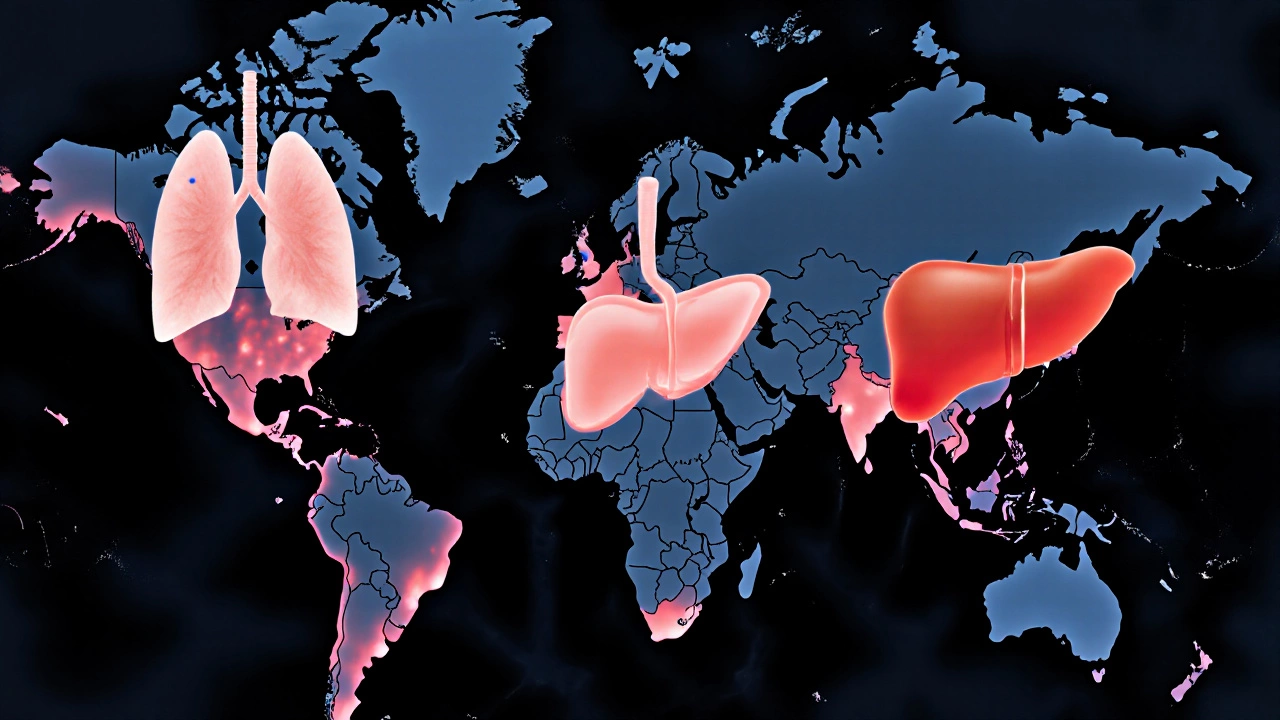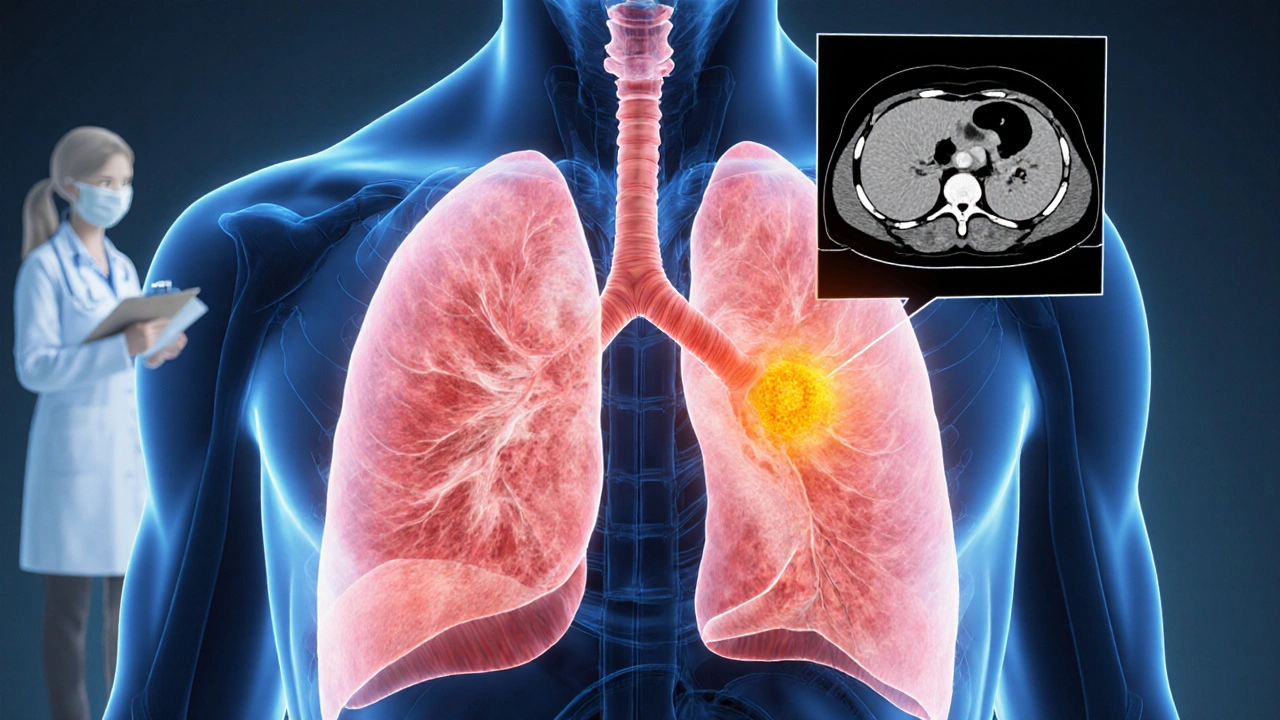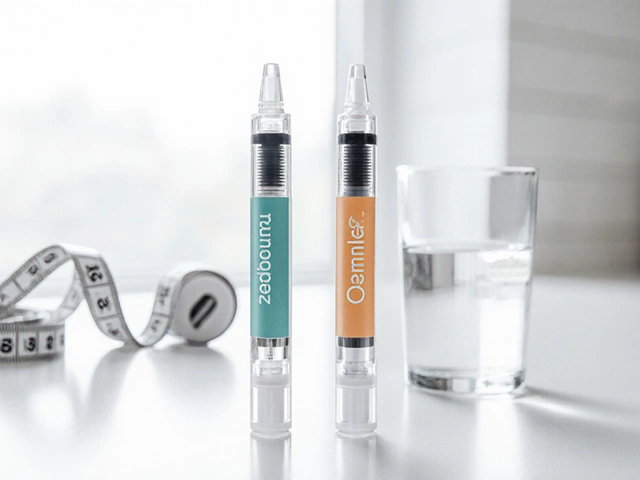- Home
- ::
- Top 3 Deadliest Cancers Worldwide - Stats, Causes & Treatment Options

Top 3 Deadliest Cancers Worldwide - Stats, Causes & Treatment Options
Cancer Risk Assessment Tool
Assess Your Risk for the Top 3 Deadliest Cancers
This tool estimates your relative risk for lung, pancreatic, and liver cancer based on factors discussed in the article. Your results will help you understand prevention opportunities.
Personal Information
Lifestyle Factors
When you hear the phrase deadliest cancers, you probably picture a grim statistic and wonder which diseases are driving that number. This article breaks down the three cancers that claim the most lives each year, explains why they’re so lethal, and shows what early‑detection steps and treatments can improve outcomes.
Key Takeaways
- Lung, pancreatic, and liver cancers together account for roughly 45% of global cancer deaths.
- Late diagnosis is the biggest reason these cancers have low survival rates.
- Targeted therapy, immunotherapy, and precision screening are shifting the outlook, especially for lung cancer.
- Lifestyle changes-smoking cessation, healthy weight, reduced alcohol-lower risk for all three.
- Understanding risk factors helps you talk to doctors about appropriate screening.
Why Cancer Mortality Matters
Worldwide, the World Health Organization reports about 19.3 million new cancer cases and 10 million deaths each year. Mortality rates differ dramatically: some cancers have five‑year survival above 80%, while others linger below 10%.
Health systems use mortality data to allocate research funds, design screening programs, and prioritize public‑health messaging. By focusing on the cancers that kill the most people, we can target prevention and early‑detection resources more efficiently.
Meet the Three Deadliest Cancers
The three cancers that consistently rank highest in death counts are:
- Lung cancer
- Pancreatic cancer
- Liver cancer
Each has unique biology, risk profiles, and treatment challenges. Let’s explore them one by one.

Lung cancer - The Global Leader
Lung cancer caused 2.2 million deaths in 2024, making it the top cancer killer for both men and women. The disease splits into two main histologies:
- Non‑small‑cell lung cancer (NSCLC) - ~85% of cases
- Small‑cell lung cancer (SCLC) - ~15% of cases
Key risk factors
- Smoking (cigarettes, cigars, pipe) - responsible for ~85% of cases.
- Secondhand smoke exposure.
- Occupational hazards - asbestos, radon, silica.
- Air pollution - especially fine particulate matter (PM2.5).
Survival snapshot: The 5‑year survival for localized NSCLC is around 63%, but drops to 7% once it spreads to distant organs.
Current treatment landscape
- Surgery - preferred for early‑stage tumors.
- Radiation therapy - often combined with chemo for stage III.
- Chemotherapy - platinum‑based doublets remain standard.
- Targeted therapy - EGFR, ALK, ROS1 inhibitors for specific mutations.
- Immunotherapy - PD‑1/PD‑L1 checkpoint inhibitors have extended survival for many advanced cases.
Recent trials (e.g., KEYNOTE‑189) showed median overall survival of 22 months for combo chemo‑immunotherapy versus 10 months for chemo alone.
Pancreatic cancer - The Silent Killer
In 2024, pancreatic cancer caused roughly 0.5 million deaths, accounting for about 7% of all cancer mortality despite representing only 2% of diagnosed cases.
Why it’s so deadly
- Late symptom onset - most patients present with jaundice or weight loss after the tumor has invaded nearby vessels.
- Highly aggressive biology - rapid proliferation and early metastasis.
- Dense stromal tissue - blocks drug delivery.
Major risk factors
- Smoking - increases risk by 2‑3×.
- Chronic pancreatitis - especially alcohol‑related.
- Obesity and type‑2 diabetes - linked to metabolic inflammation.
- Family history - BRCA2, PALB2 mutations.
Survival outlook: The overall 5‑year survival hovers around 10%; for patients eligible for surgical resection, it can reach 30%.
Treatment options
- Whipple procedure (pancreaticoduodenectomy) - only curative option for resectable disease.
- Neoadjuvant chemotherapy - FOLFIRINOX or gemcitabine‑nab‑paclitaxel to shrink tumors before surgery.
- Adjuvant chemo/radiation - improves median survival to ~24 months.
- Targeted therapy - PARP inhibitors for BRCA‑mutated cases.
- Immunotherapy - generally limited benefit, but trials with combination regimens are ongoing.
Liver cancer - The Rising Threat
Liver cancer (mostly hepatocellular carcinoma, HCC) caused about 0.8 million deaths in 2024, making it the second leading cause of cancer death in men and third in women.
Driving forces
- Chronic hepatitis B (HBV) infection - contributes to ~50% of cases worldwide.
- Hepatitis C (HCV) - accounts for ~25%.
- Alcohol‑related cirrhosis - especially in Europe and North America.
- Non‑alcoholic fatty liver disease (NAFLD) - linked to obesity and diabetes, rapidly increasing in prevalence.
Survival numbers: 5‑year survival for early‑stage HCC is about 55%, but falls below 10% once the disease spreads beyond the liver.
Therapeutic arsenal
- Curative resection - possible for small, solitary tumors with good liver reserve.
- Liver transplantation - offers 5‑year survival >70% in selected patients (Milan criteria).
- Locoregional therapies - radiofrequency ablation, transarterial chemoembolization (TACE), and Y‑90 radioembolization.
- Systemic therapy - multikinase inhibitor sorafenib, newer agents lenvatinib, atezolizumab + bevacizumab.
- Immunotherapy - checkpoint inhibitors have shown survival benefit in advanced HCC.

Comparing the Three: Survival, Detection & Treatment
| Metric | Lung Cancer | Pancreatic Cancer | Liver Cancer (HCC) |
|---|---|---|---|
| Annual deaths | 2.2 million | 0.5 million | 0.8 million |
| 5‑year survival (all stages) | 19% | 10% | 18% |
| Primary early‑detection tool | Low‑dose CT (LDCT) for high‑risk smokers | None reliable; research on circulating tumor DNA | Ultrasound + AFP; MRI for high‑risk cirrhosis |
| Top curative option | Surgery (lobectomy) + adjuvant therapy | Whipple surgery + adjuvant chemo | Resection or transplantation (Milan criteria) |
| Targeted/immune breakthroughs (2023‑24) | EGFR/ALK inhibitors, PD‑1 blockers | PARP inhibitors (BRCA), early combo immuno trials | Atezolizumab + bevacizumab, lenvatinib |
Early Detection & Prevention Tips
Even though these cancers are tough, you can lower your risk and catch them sooner with a few practical steps.
- Quit smoking - the single most effective action against lung cancer.
- Get low‑dose CT screening if you’re 55‑80 years old with a 30‑pack‑year smoking history.
- Maintain a healthy weight and limit sugary drinks - reduces pancreatic and liver cancer risk.
- Limit alcohol to ≤1 drink per day for women, ≤2 for men - protects liver.
- Vaccinate against hepatitis B and consider treatment for chronic hepatitis C.
- For people with cirrhosis or chronic HBV/HCV, undergo six‑monthly ultrasound plus AFP testing.
- Discuss genetic counseling if you have a family history of pancreatic or liver cancer.
Talk to your primary‑care doctor about personalized screening plans based on age, lifestyle, and family history.
Frequently Asked Questions
Why is lung cancer the deadliest cancer worldwide?
Lung cancer kills the most people because smoking is still prevalent, symptoms often appear late, and the disease can spread quickly. Early detection with low‑dose CT can cut deaths by up to 20% in high‑risk groups.
Can pancreatic cancer be screened?
No widely accepted screening exists yet. High‑risk individuals (familial pancreatitis, BRCA2 carriers) may enroll in research programs that test blood‑based biomarkers, but routine imaging isn’t recommended.
What lifestyle changes lower liver cancer risk?
Avoid chronic alcohol abuse, maintain a healthy weight, get vaccinated against hepatitis B, and treat any hepatitis C infection. A diet rich in fruits, vegetables, and coffee has also shown protective effects.
How effective are modern targeted therapies for these cancers?
Targeted drugs have transformed lung cancer care - patients with EGFR or ALK mutations now enjoy median survivals over 30 months. In pancreatic cancer, PARP inhibitors help a small BRCA‑mutated subset. Liver cancer sees benefit from multikinase inhibitors and combination immunotherapy, especially in advanced stages.
Is there a single test that detects all three cancers early?
No. Each cancer requires a specific approach: low‑dose CT for lung, imaging plus biomarkers for liver, and currently no reliable test for pancreatic. Ongoing research into liquid biopsies hopes to change that.
Understanding which cancers cause the most deaths gives a clear target for prevention, screening, and research. By acting on risk factors and staying informed about the latest therapies, you can improve your odds and help shape a healthier future.

 Health and Wellness
Health and Wellness





Write a comment